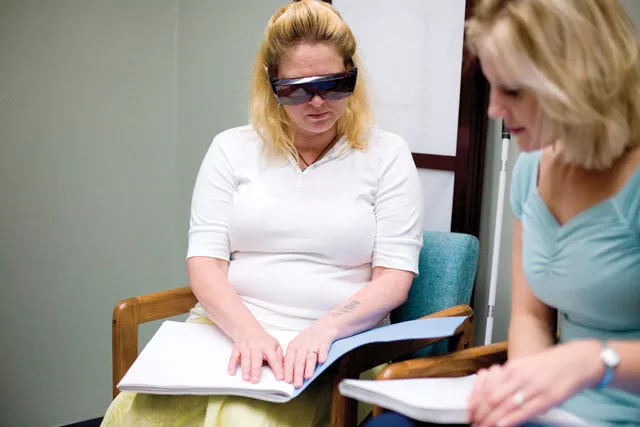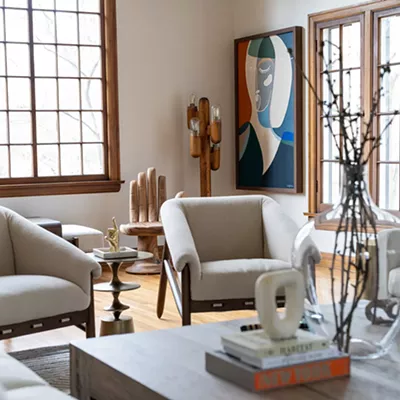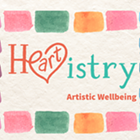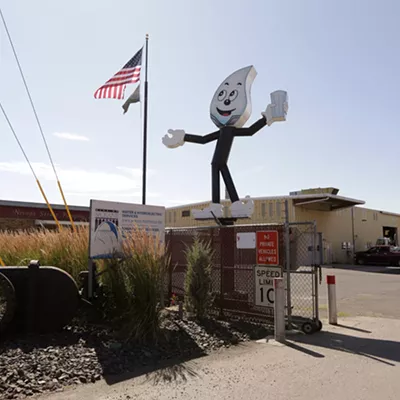
Losing your vision may be hardest when you never expected it. The summer before Charlotte Inman started to go blind, she and her new husband bought rollerblades, bikes and skis.
It took a while for Inman to notice anything was wrong. She began bumping into things, tripping over her dog. She realized she couldn’t see her fingers at all if she held them off to her side. Her peripheral vision was disappearing.
The diagnosis: retinitis pigmentosa, a condition that can progress to total blindness.
“It’s the scariest thing in the world,” Inman says. “I went from 95 percent of my sight to 10 percent in less than a year.”
As the world she had known for 44 years faded around her, Inman spent a lot of time crying. Her dog had to be given to charity. Without sight, she found herself unbalanced and had trouble standing up in the shower. Every time she got a headache, she knew it meant it her sight was going to deteriorate further.
Inman had always valued her independence. She needed to find some way to help her get that independence back. Her doctor referred her to Lilac Services for the Blind.
“You need to … get that going as soon as possible,” Inman advises those in her situation.
“[At first] the important thing is for us to actually listen,” says Mathew Plank, director of marketing and development for Lilac Services for the Blind. The organization’s goal is to help clients maintain independence and achieve a satisfying quality of life.
Inman recalls a litany of questions on her first visit: What were her hobbies? What was her life like? What would she like her life to be like?
Then the staff at Lilac Services started addressing her concerns. First came ways to mitigate her low vision. Large glasses — “Mr. Magoo glasses” she calls them — magnify what remains of her sight, allowing her to watch American Idol and Drop Dead Diva.
Staff members taught her to use a white cane, sweeping the ground in front of her as she walked. And when her cane kept getting stuck in the little cracks in the sidewalk, they got her one with a rubber stopper on the end.
She says she memorized the layout of her house, counting the number of steps it takes to get from place to place. Eventually, the bruises on her shins subsided and Inman had committed the entire layout to muscle memory. Raised dots help her use the buttons on her microwave and washing machine. Gradually, Inman is learning Braille, using egg cartons and plastic Easter eggs to form Braille letters and get a larger feel of each one.
In fact, Inman’s story is nothing new for the staff at Lilac Services for the blind. With a staff of just seven to cover 14 counties, they offer more than 3,000 devices to aid the blind — from knives with cutting guides to a talking thermometer to computer software and hardware that make it possible to do online banking and chat with friends over the Internet.
And they offer expertise. Sometimes their lessons are simple little tricks like “teaching someone how to tell the difference between Preparation H and toothpaste,” Plank says. Anything that’s poisonous like Preparation H has a little poker for puncturing the aluminum lid, he explains.
But it’s not just gadgets and gizmos Lilac Services helps with. Going blind is agonizing. It can cause confusion, fear and depression. To combat the emotional impact of her disease, Inman meets with a counselor who is also blind. Just the fact her counselor is blind and has a job is a comfort to Inman.
“I hate to sit still,” she says. She wants to get back to working and gardening.
It’s all possible, Plank explains. He goes golfing with his blind broker — who regularly defeats him. Someday the blind — or, at least, their GPS-guided cars — will even be able to drive, Plank predicts.
Great moments of joy remain in Inman’s life. She has two grandchildren on the way. “I’m not going to get to see them — but [I can experience] the smell of them and hear their voices, the laughter.”
And she’s getting a new dog — this one a seeing-eye dog.
To contact Lilac Services for the Blind, call 328-9116 or go to lilacblindfoundation.org.



















